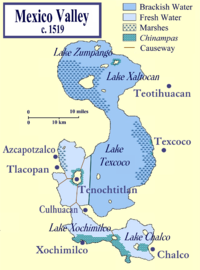
The Aztecs were a Mesoamerican culture that flourished in central Mexico in the post-classic period from 1300 to 1521. The Aztec people included different ethnic groups of central Mexico, particularly those groups who spoke the Nahuatl language and who dominated large parts of Mesoamerica from the 14th to the 16th centuries. Aztec culture was organized into city-states (altepetl), some of which joined to form alliances, political confederations, or empires. The Aztec Empire was a confederation of three city-states established in 1427: Tenochtitlan, city-state of the Mexica or Tenochca, Texcoco, and Tlacopan, previously part of the Tepanec empire, whose dominant power was Azcapotzalco. Although, the term Aztecs is often narrowly restricted to the Mexica of Tenochtitlan, it is also broadly used to refer to Nahua polities or peoples of central Mexico in the prehispanic era, as well as the Spanish colonial era (1521–1821). The definitions of Aztec and Aztecs have long been the topic of scholarly discussion ever since German scientist Alexander von Humboldt established its common usage in the early 19th century.
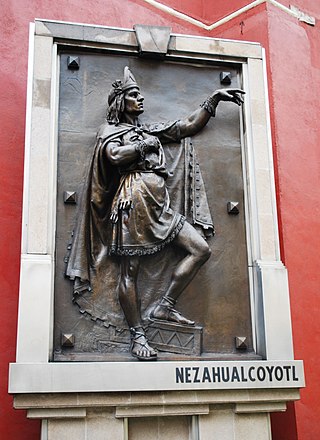
Nezahualcoyotl was a scholar, philosopher (tlamatini), warrior, architect, poet and ruler (tlatoani) of the city-state of Texcoco in pre-Columbian era Mexico. Unlike other high-profile Mexican figures from the century preceding Spanish conquest of the Aztec Empire, Nezahualcoyotl was not fully Mexica; his father's people were the Acolhua, another Nahuan people settled in the eastern part of the Valley of Mexico, on the coast of Lake Texcoco. His mother, however, was the sister of Chimalpopoca, the Mexica king of Tenochtitlan.

Chinampa is a technique used in Mesoamerican agriculture which relies on small, rectangular areas of fertile arable land to grow crops on the shallow lake beds in the Valley of Mexico. They are built up on wetlands of a lake or freshwater swamp for agricultural purposes, and their proportions ensure optimal moisture retention. The United Nations designated it a Globally Important Agricultural Heritage System in 2018.

Acamapichtli was the first Tlatoani, or king, of the Aztecs of Tenochtitlan, and founder of the Aztec imperial dynasty. Chronicles differ as to the dates of his reign: according to the Codex Chimalpahin, he reigned from 1367 to 1387; according to the Codex Aubin, he reigned from 1376 to 1395; and according to the Codex Chimalpopoca, he reigned from 1350 to 1403.

Itzcoatl (1380–1440) was the fourth king of Tenochtitlan, and the founder of the Aztec Empire, ruling from 1427 to 1440. Under Itzcoatl the Mexica of Tenochtitlan threw off the domination of the Tepanecs and established the Triple Alliance together with the other city-states Tetzcoco and Tlacopan.

Huitzilihuitl or Huitzilihuitzin was the second Tlatoani or king of Tenochtitlan. According to the Codex Chimalpahin, he reigned from 1390 to 1415, according to the Codex Aubin, he reigned from 1396 to 1417 and according to the Codex Chimalpopoca, he reigned from 1403 to 1417.

Chimalpopoca or Chīmalpopōcatzin (1397–1427) was the third Emperor of Tenochtitlan (1417–1427).
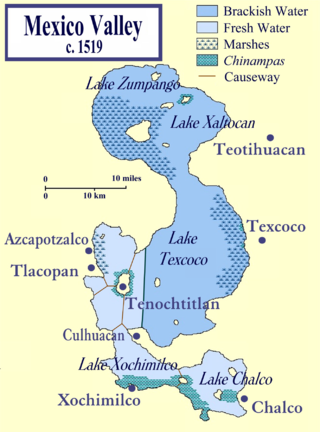
Tlacopan, also called Tacuba, was a Tepanec / Mexica altepetl on the western shore of Lake Texcoco. The site is today the neighborhood of Tacuba, in Mexico City.

The Aztec Empire or the Triple Alliance was an alliance of three Nahua city-states: Mexico-Tenochtitlan, Tetzcoco, and Tlacopan. These three city-states ruled that area in and around the Valley of Mexico from 1428 until the combined forces of the Spanish conquistadores and their native allies who ruled under Hernán Cortés defeated them in 1521.

The Aztecs were a Pre-Columbian Mesoamerican people of central Mexico in the 14th, 15th, and 16th centuries. They called themselves Mēxihcah.

The altepetl was the local, ethnically-based political entity, usually translated into English as "city-state," of pre-Columbian Nahuatl-speaking societies in the Americas. The altepetl was constituted of smaller units known as calpolli and was typically led by a single dynastic ruler known as a tlatoani, although examples of shared rule between up to five rulers are known. Each altepetl had its own jurisdiction, origin story, and served as the center of Indigenous identity. Residents referred to themselves by the name of their altepetl rather than, for instance, as "Mexicas." "Altepetl" was a polyvalent term rooting the social and political order in the creative powers of a sacred mountain that contained the ancestors, seeds and life-giving forces of the community. The word is a combination of the Nahuatl words ātl and tepētl. A characteristic Nahua mode was to imagine the totality of the people of a region or of the world as a collection of altepetl units and to speak of them on those terms. The concept is comparable to Maya cah and Mixtec ñuu. Altepeme formed a vast complex network which predated and outlasted larger empires, such as the Aztec and Tarascan state.
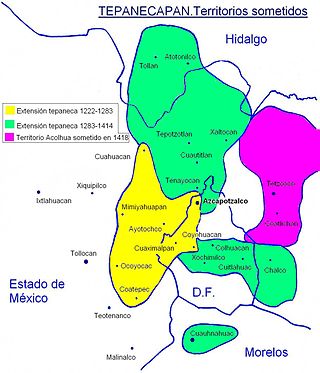
The Tepanecs or Tepaneca are a Mesoamerican people who arrived in the Valley of Mexico in the late 12th or early 13th centuries. The Tepanec were a sister culture of the Aztecs as well as the Acolhua and others—these tribes spoke the Nahuatl language and shared the same general pantheon, with local and tribal variations.

The Acolhua are a Mesoamerican people who arrived in the Valley of Mexico in or around the year 1200 CE. The Acolhua were a sister culture of the Aztecs as well as the Tepanec, Chalca, Xochimilca and others.
Culhuacan was one of the Nahuatl-speaking pre-Columbian city-states of the Valley of Mexico. According to tradition, Culhuacan was founded by the Toltecs under Mixcoatl and was the first Toltec city. The Nahuatl speakers agreed that Culhuacán was the first city to give its rulers the title of "speaker" (tlatoani). In the sixteenth century following the Spanish conquest of the Aztec Empire, Culhuacan was incorporated into colonial New Spain and called a pueblo, but in local-level documentation in Nahuatl, residents continued to use the designation altepetl for their settlement.

The Mexica were a Nahuatl-speaking people of the Valley of Mexico who were the rulers of the Mexica Empire. The Mexica established Tenochtitlan, a settlement on an island in Lake Texcoco, in 1325. A dissident group in Tenochtitlan separated and founded the settlement of Tlatelolco with its own dynastic lineage. In 1521, they were conquered by an alliance of Spanish conquistadors and indigenous people including the Tlaxcaltecs led by Hernán Cortés.

Azcapotzalco was a pre-Columbian Nahua altepetl (state), capital of the Tepanec empire, in the Valley of Mexico, on the western shore of Lake Texcoco.

Tlatelolco was a pre-Columbian altepetl, or city-state, in the Valley of Mexico. Its inhabitants, known as the Tlatelolca, were part of the Mexica, a Nahuatl-speaking people who arrived in what is now central Mexico in the 13th century. The Mexica settled on an island in Lake Texcoco and founded the altepetl of Mexico-Tenochtitlan on the southern portion of the island. In 1337, a group of dissident Mexica broke away from the Tenochca leadership in Tenochtitlan and founded Mexico-Tlatelolco on the northern portion of the island. Tenochtitlan was closely tied with its sister city, which was largely dependent on the market of Tlatelolco, the most important site of commerce in the area.
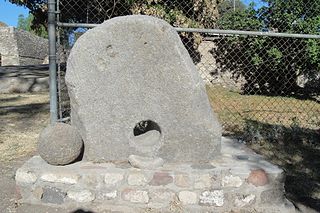
Huexotla or Huexotla is an archaeological site located 5 kilometers south of Texcoco, at the town of San Luis Huexotla, close to Chapingo, in the Mexico State.

Xochimilco was the most important city of the Xochimilca people, one of the Nahua tribes that migrated to the Mesoamerica region. At the same time it was the name of the altepetl of this group and historically referred to both interchangebly. The city was founded around 900 AD. It grew to become an important city in the Valley of Mexico, until in 1430, the Mexica of Tenochtitlan succeeded in conquering the city.
Teotlalpan was the pre-Columbian name of a region in the north of Valley of Mexico comprising what is today the Mezquital Valley in the state of Hidalgo and adjacent areas in the State of Mexico. The region was one of two regions settled by Otomí people, the other being the region around Jilotepec and Tula, Hidalgo. In the 18th century the name of the main part of the region came to be known as Mezquital.
